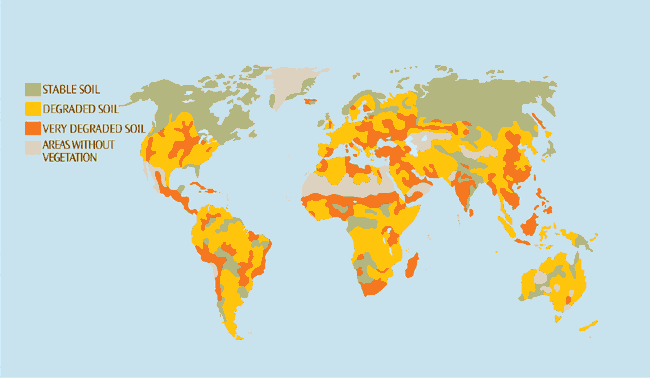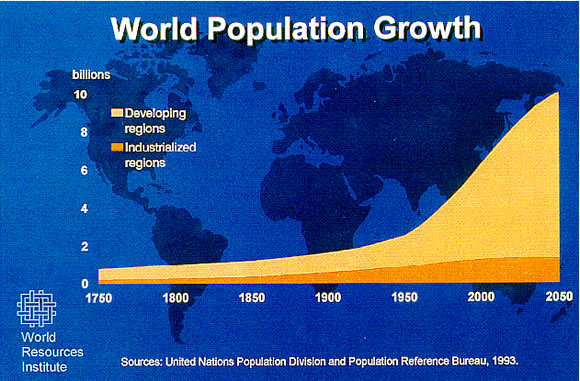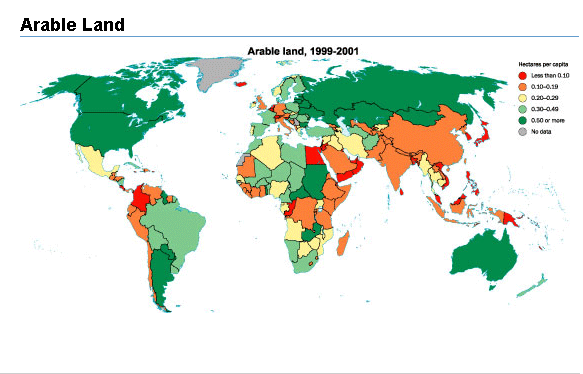There is a finite amount of arable land on which to raise food crops and livestock on our planet. There is only so much freshwater to go around. So if today we are struggling to feed more than 1 billion of the 7 billion on Earth, what do we need to do to ensure that 2.5 billion more mouths within the next 40 years do not starve.
Note the graph below. Where will we see the bulk of future population growth? Certainly not in the Developed World where we have agricultural surpluses, but in the Developing World where there are far more agricultural challenges and a burgeoning population.
What is in our arsenal tools to make food affordable and accessible for all on this planet? In a paper appearing in the May 2013 issue of Nature scientists talk about creating specialized plant membrane transporters to enhance crop yields. The goal will be to expand the amount of land available for growing food through re-engineering of plants to tolerate salinity, toxicity and aridity. The key is in identifying genes in plants that control absorption and transportation of food and nutrients and that heighten the plant’s natural defenses to combat environmental insults.
The authors of the paper located specific genes responsible for the proteins that regulate the pathways from root to leaf tip. In identifying these genes and understanding the regulatory process, they believe they can introduce through genetic modification and in some cases selective breeding, desirable characteristics to improve crop yields.
It is the finite amount of land suitable for agriculture, (see map above) about 36% of our total global land mass, that is the single most limiting factor for agriculture in addressing a future with 9.5 billion mouths to feed. So much of our planet’s soil, up to a third, is too acidic, too saline, or so filled with aluminum, sodium and other toxic minerals that we cannot grow food in it. And on the arable land we do have, poor farming practices have depleted minerals and nutrients from the soil in many areas making agriculture no longer productive beyond a subsistence level. That’s why breeding new strains of staple crops that tolerate depleted or currently unsuitable soils is critical for human sustainability.
Not all the news is bad. Recent examples of successes include the development of new commercial wheat variety that incorporates salt-tolerance from wild wheat species. This new wheat variety is now being grown in an area of Australia (see image below) that was deemed unsuitable for agriculture in the past because of high levels of soil salinity. The second example is a new variety of sorghum that is acid-soil tolerant, making it suitable for growing in tropical and sub-tropical soils.
For those whose strong beliefs put them in opposition to genetically modifying plants, it is important to understand that we can only do so much in selective and cross-breeding to increase agricultural yields for staples like wheat, rice, corn, and sorghum. Genetic modification is and will be the key to meet 9.5 billion mouths to feed. Why?
- Manipulating genes is the fastest way for us to develop the next generation of crops that can grow where we have been unable to produce food in the past.
- Manipulating genes is the principle way we can grow plants faster so that we can intensify production.
- Manipulating genes is the most effective way to ensure food-bearing plants assimilate native phosphorus, zinc, iron and nitrogen, to improve crop yields.
- Manipulating genes is the best way for us to reduce the use of artificial fertilizers made from fossil fuels, and by doing so, helping us to combat climate change.
- Manipulating genes is the best way for us to produce crops that have immunity to weed and insect infestations.That way we can stop using herbicides and pesticides with impunity.
- Manipulating genes may be the best way for us to produce crops that store better and longer so that there is less spoilage. This addresses the challenge we face today with almost half of what we grow spoiling before it gets to hungry mouths.
- Manipulating genes may be the fastest way for us to create crops that, by the kilogram, are more nutritionally substantive than anything we have created by more traditional agricultural means.
The anti-frankenfood movement comes from so many of us who are already well-fed, not from those who are barely surviving. It is also a reaction to the predatory licensing practices of the chemical and agri-biotech companies that today dominate the field of genetically modified foods. And, of course, there is the organic farming movement and its premium prices for food, a luxury that we in the Developed World can afford, but simply beyond the means of most in the Developing World.
That’s why gene manipulation both within species or inter-species (what is referred to as transgenic) is likely our best solution to ensuring 9.5 billion bellies will be filled every day in the year 2050.













The answer is NOT genetic manipulations of plants which has proven to lower fertility and cause cancer.
The answer to build up the soil again through no-till farming, permaculture practices and holistic grazing of live stock. This is not a problem. It only has to be done.
Another big issue is of course the profit based monetary system, which drives companies like Monsanto and more to patent GMO seeds and a lot of other practices that are not necessary for anything else than monetary profit. This research is not good for people or the planet. The above mentioned is what we need. Not GMO. GMO is not necessary.
Thus, another view on ‘economy’ is paramount. A global resource based economy can be one solution. http://www.theresourcebasedeconomy.com
Hi Harald, Thank you for pointing out the need to alter our methods of farming so that we can get better yields without GMO. As for the issue of cancer I have yet to see a scientific paper that presents GMO as a cancer-causing agent. The only study done in France was seriously flawed as I have reported several times in postings here. And there doesn’t seem to be a difference in my mind between selective breeding using cross pollination and grafting of plant stocks and grafting genes into the DNA of a cell to improve the quality of a plant being grown. And as for genetic migration between species, this has been happening among plants since they first evolved. All we humans are doing now is replicating what nature has shown us is possible.
What burns me about Monsanto is the culture of predatory dominance they exert on agribusiness. If they were to create an open source scientific approach to genome research, considering the billions they already make from the many chemicals they patent and produce then all would benefit. I think have the resistance to GMO comes as a reaction to Monsanto, Dupont, BASF and others who have made the growing of modified basic food staple crops into a quasi-monopoly in which they control what farmers grow, where they grow it, and limit the farmers ability to do any experimenting on their own (the latter the traditional way we always selected promising varieties of plants for seeding, growing and harvesting).
[…] El imparable crecimiento de la población mundial […]